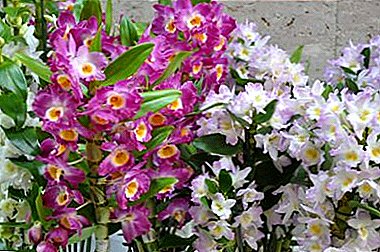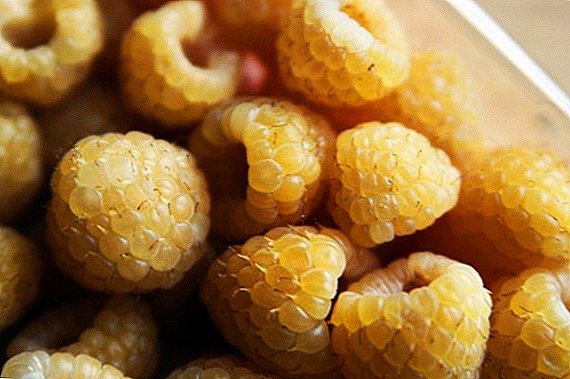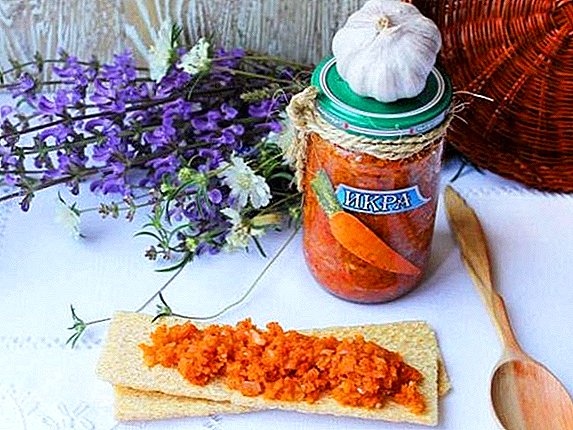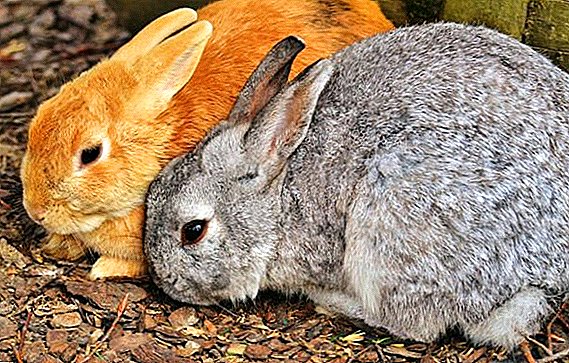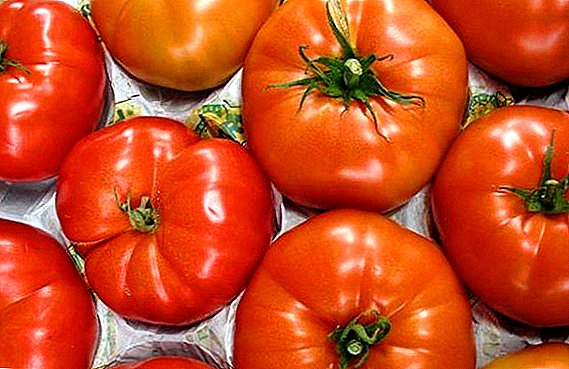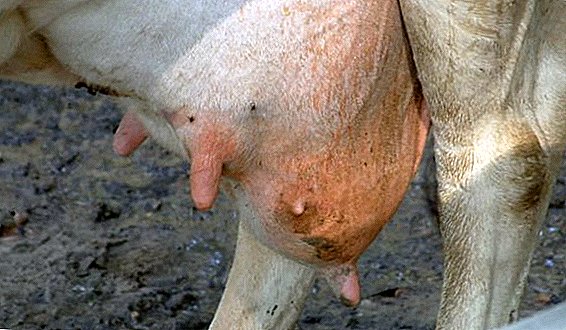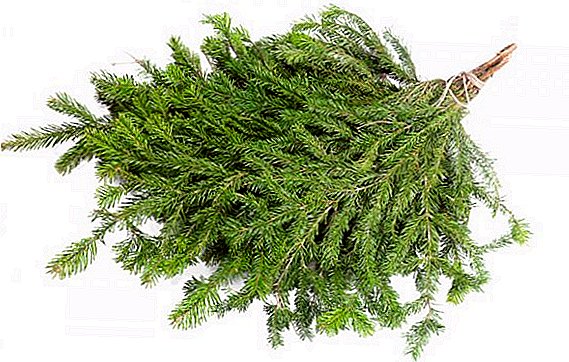 Many gardeners and owners of private houses, whose possessions are located near the coniferous forest, know perfectly well what is the spruce branches. They actively use this natural resource on their land plot. Let us take a closer look at what lapnik is and how to use it to protect crops.
Many gardeners and owners of private houses, whose possessions are located near the coniferous forest, know perfectly well what is the spruce branches. They actively use this natural resource on their land plot. Let us take a closer look at what lapnik is and how to use it to protect crops.
What is lapnik
Lapnik called harvested coniferous tree branches. Usually it is spruce, rarely pine and fir. Their branches are called paws, and broken branches - lapnikom. 
Where applicable
On land plots the spruce branches are used for the following:
- for shelter of young saplings for the winter from a frost;
- protection of tree trunks and shrubs from rodents and burns from the active spring sun;
- shelter from the winter cold for heat-loving perennials;
- shelter from frost podzimnyh crops;
- retention of snow on the site.
Read also about the varieties and cultivation of spruce in the area: ordinary, Serbian, Glauka, Engelman, Konik (in open field, in a pot), blue (varieties, cuttings, from seeds), diseases and pests of spruce.
How to collect it
Lapnik can be prepared in spruce and pine forests. Some gardeners can collect this material in their own area, pruning coniferous plants used in garden design. Fir trees are often planted for wind protection or as an almost impassable hedge.  It should be noted that spruce branches cut in the woods, it is important to inspect for traces of diseases and parasites, so as not to bring them to your site. Branches with various growths on the bark, cobwebs, insects, suspicious color needles should not be cut off. It is better to look for a clean and healthy material for harvesting.
It should be noted that spruce branches cut in the woods, it is important to inspect for traces of diseases and parasites, so as not to bring them to your site. Branches with various growths on the bark, cobwebs, insects, suspicious color needles should not be cut off. It is better to look for a clean and healthy material for harvesting.
Important! Before harvesting coniferous branches, you should be familiar with the laws in force at the gathering places (Forest Code), so as not to pay a fine.
Ways of shelter
Depending on the type of plant crops and the purpose of protection, apply such ways of sheltering spruce branches:
- coniferous branches are simply laid out on top of the wintering areas or tree trunks for snow retention and protection from low temperatures;
- spraying fir branches. Around the bushes and trees decomposed this shelter creates a greenhouse effect, and also protects well from various rodents;
- lap branches are tied to tree trunks to protect them from rodents and spring burns;
- simple protection with spruce branches. This method is used to protect perennials, lawn conservation. For this purpose, first they are covered with dry foliage, and then laid out coniferous twigs;
- using wire mesh. It is placed on the ground around a shrub or tree, and then covered with dry leaves, and pine branches are laid on top;
- crown wrapping. This method is used for trees. Their crowns are carefully wrapped in pine branches, fixing to the trunk with string. This well protects the trunk from cracking due to severe frosts;
- installation of a shed of burlap and spruce branches. This method is good to apply for heat-loving crops with fragile branches. Create a frame of rails and sticks, the top bind. On top of this design is covered with burlap, and the bottom edge is fixed with stones. Then a lapnik is placed on top, in which the tops are fixed, and the branches are instilled from the bottom.


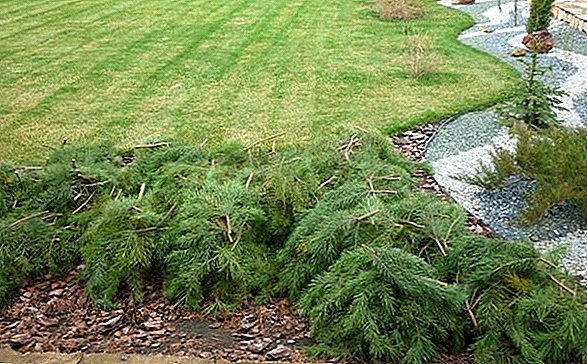


Important! In the Botanical Garden of Moscow State University. MV Lomonosov measured the temperature of the air under the huts of lapnik and outside it and found that the inside is not colder than -5 ° C, even at -30 ° C outside. With an outdoor temperature of -5 ° C in this shelter was -3 ° C. But in the absence of snow, the temperature inside and outside the shelter was the same. Therefore, during a snowless winter, you should take advantage of additional protection.
When to use it
Cover plants with spruce branches when the air temperature reaches below -5 ° C. It is undesirable to carry out the procedure before, as the plants need to harden a little and get used to lowering the temperature. This is usually the first half of November. Spruce and pine branches contribute to the accumulation of snow, which will protect against severe frosts.
Familiarize yourself with the main species and varieties of pine: common, weymouth, Siberian cedar, mountain, black, and stanic.
But it is worth considering that the hut of such branches is a great place to stay for mice, they like a warmer place in such shelters. In order for these animals not to bite the bark of the trees, it is necessary to put poison into the shelter.
Lapnik is always placed in such a way that the upper side of the fir branches, where the needles are needles are thick, are directed upwards.  They remove such a coniferous shelter when the snow melts and the temperature is set in the range from 0 ° to + 5 ° C. This usually happens at the end of March. It is advisable to do this gradually - first remove the lapnik, and after a couple of days to remove the burlap.
They remove such a coniferous shelter when the snow melts and the temperature is set in the range from 0 ° to + 5 ° C. This usually happens at the end of March. It is advisable to do this gradually - first remove the lapnik, and after a couple of days to remove the burlap.
Did you know? From the needles of fresh pine paws, you can make inhalations for colds. To alleviate the condition of the patient, it is also useful to decompose steamed coniferous branches indoors - their smell inhibits many pathogens of infectious diseases. Bathing pine needles tones, relieves fatigue, eliminates rashes.
What cultures need to be protected
The shelter of spruce need gentle, exotic and unsuitable for severe frost plants.
These are primarily the following cultures:
- only saplings of apple trees and other trees and bushes planted in autumn;
- subwinter crops of greens, carrots and others;
- almost all types of roses;
- clematis, chrysanthemums, peonies;
- bulbous and rhizomatous perennials (lilies, hyacinths, irises, and others);
- weigel bushes, buddley, deytion;
- rhododendrons;
- lavender;
- grapes;
- grass for lawn;
- young spruce, juniper, tui (up to five years).
When sheltering coniferous branches of different plant species, their features should be considered.
So bushes weigela buddley first you need to loosen and pile up, and then cover it with peat or prepared compost. After they are covered with foliage and coniferous branches.  Irises, Peonies and Chrysanthemums first sprinkled with sand, and then covered with sprigs of pine or spruce.
Irises, Peonies and Chrysanthemums first sprinkled with sand, and then covered with sprigs of pine or spruce.
Clematis first cut and carry out prevention of fungal diseases, and then produce mulching of the soil. The long lashes of this flower are neatly folded and wrapped in a twig.
Lawn before hibernation pierce with forks for free access of air, and after scattering mulch and sprigs of needles.
Roses need a combined shelter. At first they are loosened and spud, then they are sprinkled with sand (about 20 cm), peat is brought on top (about 10 cm). Around the bush make the frame of the branches or placed boxes of wooden plates, and covered with pine branches on top.
For young Christmas tree, thuya and juniper additionally use burlap and spunbond. This will allow the pine branches not to break under the weight of snow, and in the spring will protect against sunburn.
Read also about the advantages and disadvantages of covering materials such as agrotex, agrospan, lutrasil.
The grapes are first pruned and then the remaining vine is placed on the prepared spruce branches. After that, the vine is tied and fixed with the help of a wire to the ground along the beds. The top is covered with coniferous branches about 6-10 cm thick and placed boards from boards, and then the whole structure is covered with roofing felt or polyethylene film. Thus, the vine and the roots of the grapes are reliably covered from winter frosts. In addition, a dry vine does not touch the ground, and necrosis does not threaten the grapes. 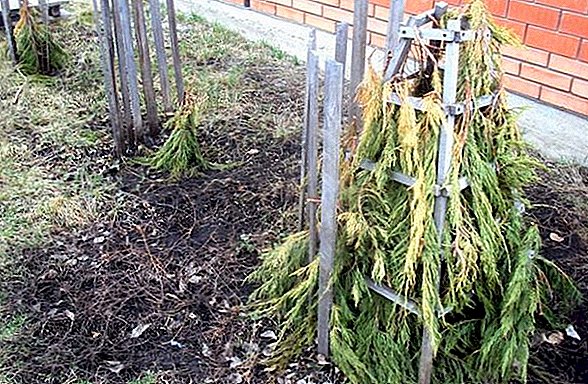 If the frosts in the region are severe, then the trunks of fruit trees are also subjected to winding with pine branches, and the roots are warmed with them.
If the frosts in the region are severe, then the trunks of fruit trees are also subjected to winding with pine branches, and the roots are warmed with them.
The benefits of spruce branches
Spruce spruce branches as an element of protecting crops from frost in the winter period has a list merits:
- perfectly protects from sleet, rains, gusts of cold wind, as well as from the formation of ice crust;
- creates a warm air layer, which passes oxygen well, prevents the plant from overheating;
- performs the function of protection against sunburn;
- protects against negative impact due to sharp fluctuations in temperature;
- pine and spruce branches are not susceptible to rotting, they are not formed harmful for plant crops, fungi, mold, etc.;
- delays snow on the plot;
- protects from rodents.

disadvantages
Despite the fact that lapnik is a wonderful shelter for the winter, he has the following limitations:
- since it is forbidden to break branches from growing trees, only from sawn ones, it is not always possible to assemble it;
- with spruce branches from the forest you can bring pests (ticks and bugs) and diseases that will harm healthy crops in the garden;
- needles oxidize the soil, which does not like many plants.
Did you know? The pine forest has a beneficial effect on the respiratory, nervous and cardiovascular systems. Such walks are especially advisable for asthmatics. Walking through the fir forest is favorable for the nerves, the fir smell strengthens and tones the body, invigorates. This is very useful for weak or elderly people, children.
Video: plant shelter with spruce branches
Shelter plants spruce branches: reviews


Lapnik is an excellent natural material for shelter for the winter of many crops growing on a private plot. They can protect the trunks of trees and bushes from rodents and the active spring sun. It has a number of advantages in comparison with other covering materials, the main of which is to let in air and trap snow. You can prepare it yourself in the places of deforestation from coniferous trees or by pruning coniferous plants in the garden.


